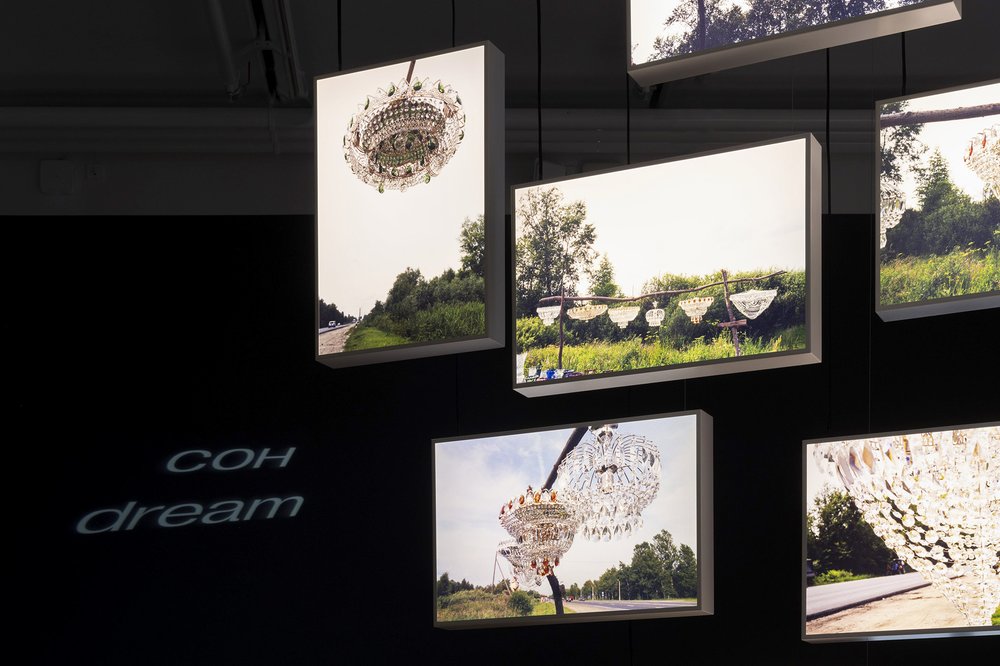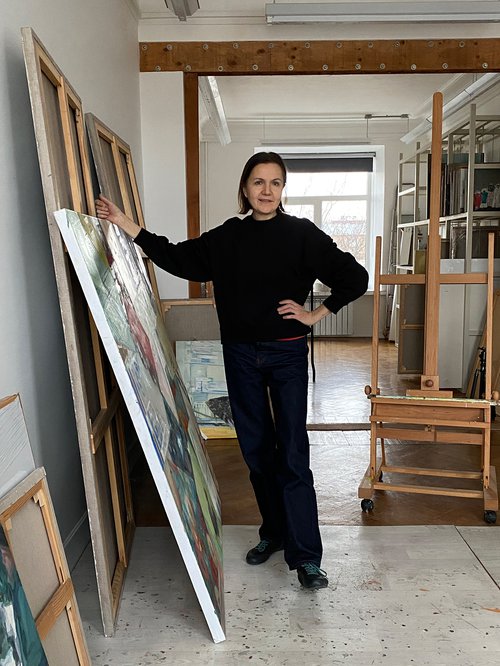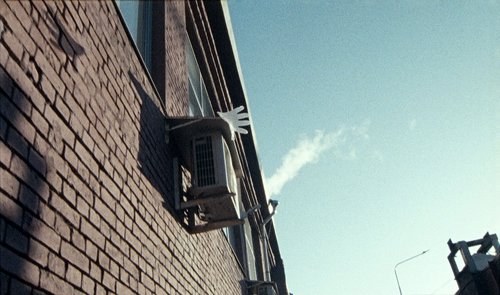Viktor Misiano on Dreams, Chernysheva and Chekhov

Dream Street. Exhibition view. Moscow, 2025. Photo by Daniel Annenkov. Courtesy of GES-2 House of Culture
Celebrated Russian art curator Viktor Misiano met with Art Focus Now to talk about Olga Chernysheva’s latest exhibtion ‘Dream Street’, curated by him and Elena Yaichnikova at GES-2 in Moscow, and the role of an artist’s national identity in the art world today.
I caught up with Viktor Misiano in Moscow at the restaurant in GES-2 on the morning of the first day of the exhibition, a rare opportunity as he lives today between Russia and Italy. Misiano (b. 1957) is a curator, critic and art theorist with an international reputation, having taken part in countless art biennales across the world - in Istanbul, Valencia, Venice, São Paulo and Manifesta in Rotterdam and he has curated the Russian pavilion at the Venice Biennale several times. He has curated major exhibitions of post-Soviet art in Europe and America and he is associate Professor at the New Academy of Arts in Milan and Professor Emeritus at the University of Art and Design in Helsinki as well as a seasoned guest lecturer at many universities around the world, including in the UK and the USA. Back home in Russia he is known not only as a curator, but also as founder and editor-in-chief of Moscow Art Magazine, an intellectual publication about contemporary art which was first published in 1993.
Oleg Krasnov: One of the counterpoints of the exhibition concept is Anton Chekhov’s travelogue ‘Steppe’ about the journey of a young boy with a salesman and priest across Russia’s epic expanses and about his observations of what he sees happening around him. Do you think it is worth reading before or after seeing the show?
Viktor Misiano: I’ve actually tried to downplay the importance of this story. Chekhov’s text is not only about the boy, but seen as if through the prism of his consciousness and the key is that this story is told by a consciousness that is not yet fully rational, in which the fairy tale, the fabulous and the imaginary have not yet been replaced by rational adult thinking. And this manifested itself in our work on the exhibition to such an extent that the original text was forgotten. And when we began to edit my introductory text for the exhibition, Olga would say: “Let’s remove Chekhov here, and here, and here too...” And ultimately he remained only at the very beginning. But mentioning Chekhov’s story allows a mythopoetic construction of the exhibition.
OK: So Chekhov helped you decide on your approach?
VM: Yes. This is an exhibition that does not tell a linear or direct story about the work of the artist. It exists in its own mythopoetic state, where different themes or leitmotifs that run through the exhibition also connect in Olga’s work.‘Dream Street’ is an appeal to the dreamlike. It addresses a problem that was of great interest to culture of the 20th century: subconscious experience, the world of visions, the experience of dreams, the world of non-awake consciousness. It is our task to immerse the exhibition goers into this kind of poetic state.
OK: Olga Chernysheva is a multidisciplinary artist who works – in her own words – through method rather than technique. What do you see as her main method?
VM: Let’s take a point of reference: Olga is a graduate from the animation department at VGIK (now All-Russian State University for Cinematography in Moscow – ed.). I think her basic method is very connected to what she was taught at the institute which was the moving image. We even see this in her drawings. One image is not enough for her – if she draws ducklings, she creates a large series of images. If she captures the image of a man in a furry costume, she makes several drawings at once. And it is the same with her photography where she always makes a series. This dynamic of images which evolve and are in some kind of state of development is important. So I think her main method is animation and that is probably the key to understanding her methodology.
OK: Chernysheva is the winner of the Guerlain Drawing Prize, and she has had quite a few exhibitions in different countries around the world, from collective exhibitions, like the main project of the Venice Biennale, to small solo exhibitions in galleries and museums in Europe and America. To what extent is her artistic output Russian or global?
VM: I don’t know of a more national artist than Olga Chernysheva and I have no idea why her work is in such demand abroad (laughs). The myth of globalization as being a kind of unified standard is a deep misconception. The world is interested in specificity. Global, if it exists as a concept exists only as an alternative and a link to the local. A concept is born and formed only when there is an alternative to it, otherwise there is no way it can crystallize. Indeed, there is no artist who is so consistently and organically rooted in the traditions of Russian culture and Olga is very connected to Russian literature, which she knows well. She does not like nationalism or any kind of deliberate fixation. She has a connection to the 19th century, which was a great era in the development of Russian literature – so it is not by chance that Chekhov appeared in the concept of the exhibition. Leskov, a very national and little translated writer, is also important to her. And Yuri Olesha with his endless notes and fragments is very close to her in terms of structure, because all her works are based on observations of one kind or another. By the way, the national is also largely in her method of work. Because she is not an artist of the imagination, she is an artist of observation.
OK: When was the first time you worked together as a curator with an artist?
VM: It was 1991 and my first exhibition as an independent curator in Moscow: ‘Aesthetic Experiments’ which took place in Kuskovo (a museum-estate near Moscow). We knew each other well by then, I often used to visit the squat where she and other artists had their studios. I took for the exhibition her objects ‘cakes’, where the layers of dough were canvases on stretchers, and oil paints played the role of cream. Later she also participated in a large series of exhibitions in Europe called ‘Progressive Nostalgia’.
OK: How much has her international career lined up?
VM: The world of contemporary art is very multilayered and there are many different criteria for success. You could say artists in great commercial demand on the market have success, or those who make monumental installations. At the same time there are artists who do not tick those boxes but are very authoritative in the professional field, which is not so narrow. And it seems to me that Olga is an example of such a thoughtful, serious, and very original artist. She is recognised in the professional world, her work is followed and treated with great respect. So the fact that there are no million-dollar sales at Sotheby’s for her work does not detract from this. She does not set such goals for herself! It seems to me that the type of artist she is, well that is real ambition, because such artists play big, they play for a place in history, not for a presence in the here and now.
OK: In this story, especially now, how important is the nationality of an artist?
VM: Of course, it always plays a role, because the fate of an artist is deeply influenced by the development of infrastructure, promotional opportunities of market infrastructure and institutional infrastructure. So the chances of a German or French artist becoming internationally known are obviously higher than a Czech artist. And then, if we are talking about the Russian situation, then of course the political context today does not favor the promotion of Russian artists. Because Russia's ties with the institutional world have been interrupted and are still blocked. The possibilities of exchange and movement are complex and all this does not help the Russian artist.
However, I do not see any serious ‘cancel culture’ in the world, that is, some kind of deliberate desire to exclude Russian artists from being on the scene. In some ways it is even the opposite: Russia is receiving attention, understandably, not always favourable. But hence there is an interest and a desire to look for some answers in culture, in art, about the country with which certain events are connected.
This does not mean that an artist must necessarily take a position. Smart curators, smart institutions do not demand this, they realise that this is crass and stupid. But it is really necessary to preserve dialogue, it is important.























